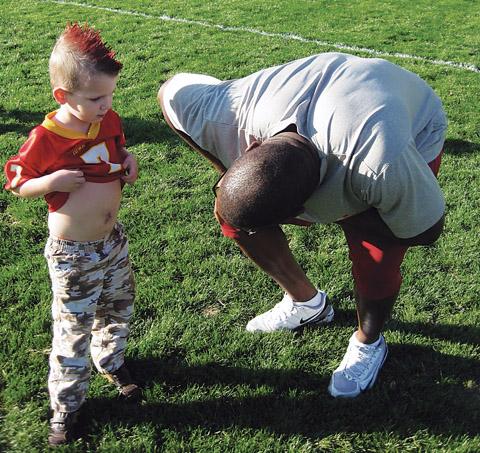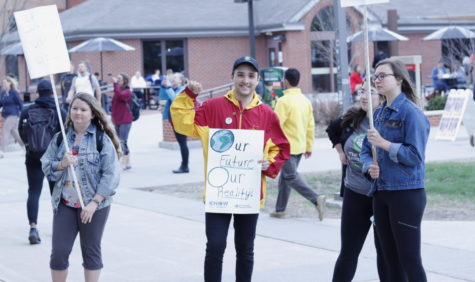Local child connects Ames community to ISU blood drive
September 26, 2010
Six-year-old Eli Horn’s parents stopped counting how much blood their son received after 50 units.
It wasn’t about the little things during his chemotherapy treatment anymore — it was about Eli’s survival.
“It became such a normal thing for Eli to need a unit of blood that we didn’t even think about it,” said Aaron Horn, Eli’s father.
Eli was 3 years old when he was diagnosed with stage 4 neuroblastoma — a sentence that gave him a 30 percent chance of surviving until his eighth birthday.
“Hearing that your child has cancer is absolutely crushing,” Aaron said. “You feel pretty numb from head to toe, and it only gets worse as the doctors describe what it will be like for your son to go through chemotherapy, radiation and painful treatments. It was devastating and it was hard, but you handle it because you have no other choice. You get up and start fighting and researching and doing whatever it takes because doing nothing isn’t an option.”
Eli started fighting the day he was diagnosed. The family spent 32 straight days in an Iowa City hospital to begin the 3-year-old’s first round of chemotherapy.
“We would go home for a week or two and then back to the hospital for another few weeks of treatment,” Horn said. “When we would go home, Eli would often [have no immunity due to low blood counts] and any kind of simple infection — like a cold — could give him a dangerous fever and we’d have to go straight back to the hospital. Most of his chemo treatments would be a week or so of getting chemotherapy every day, and then spending weeks recovering from the chemo wiping out his [red blood cell, white blood cell and platelet] counts.”
Eli’s lifeline became blood — from complete strangers.
“Eli would be getting red blood and platelet transfusions when these levels would drop dangerously low,” Aaron said. “Sometimes he would need blood and/or platelets every day for a while until his body could start producing its own again.”
But it wasn’t enough. Eventually the Horns had to drive nearly 19 hours to New York City for Eli to receive treatment at the Memorial Sloan-Kettering Cancer Center.
MSKCC is the only facility in the world that offered a 3F8 antibody treatment that could aid in combating neuroblastoma.
The Horns stayed at the Ronald McDonald House a few blocks from the treatment facility at $35 per night for one year.
“It’s much like a hotel with shared kitchen spaces and a playroom for the kids,” Aaron said. “Most of the families in the Ronald McDonald House were neuroblastoma families, which was a great resource of ideas and support.”
Eli, still 4 years old, stayed positive.
“Eli understands that his treatments are necessary to get rid of the ‘bad cells’ in his body,” Aaron said. “His antibody treatments are extremely painful, but he bravely walks through the door every day to get the treatment and knows that we will be there with him and that the pain is temporary and necessary. Eli’s attitude is positive, inspiring and courageous.”
But Eli kept fighting, and eventually returned home to Ames — just in time for the 2008 Iowa State-Kansas football matchup.
Parents of ISU football players and friends of ISU staff heard of Eli’s illness and frequently checked his progress. Several individuals contacted coach Gene Chizik about involving Eli in the team’s preparation for the game.
Eli was invited to a practice and got a first-hand experience of game day for the Cyclones.
“Eli did the spirit walk with the football players, and they marched him right into the locker room where he had his own locker and jersey with his name on it. He hung out with the players and played catch with them before the game,” Aaron said.
In return, Eli brought ‘Eli’s Army’ wristbands for the players — an accessory ISU captain and quarterback Austen Arnaud still wears during games.
“It was important for Eli to see that even big, tough football players care about him and support him,” Aaron said. “Eli was grinning from ear to ear and had an absolute blast.”
“You often hear pediatric cancer kids being referred to as heroes, and I think it’s very fitting,” Aaron said. “They face their challenges with unbelievable bravery and courage. They know that the treatment will be painful and will make them sick, but they also know that it’s necessary to make them better so they push through.”
Eli’s parents aren’t the only ones who admire Eli’s perseverance.
“People think that we make a big sacrifice playing football, and you know, we’re getting beat up and all the man hours we put in — that has no comparison to what Eli’s going through,” Arnaud said in a feature on the “Paul Rhoads Show” about Eli’s visit to Jack Trice.
The admiration doesn’t stop there. Community members and friends of the Horns now give blood donations in Eli’s honor.
“I think it was easy for me personally to take for granted that blood would always be available for Eli when he needed it,” Aaron said. “The reality is that there are often times where the blood blank is low on blood and really needs donations to keep coming in so they have enough blood for the needs that arise every day. Not just for pediatric cancer patients — but for all kinds of patients.”
But Eli’s story isn’t an uncommon one, even in Ames, and it’s the reason ISU students work to put together one of the largest student-run blood drives in the country.
It’s also why some coordinators and committee members get involved.
“I’ve had family that needed a blood transfusion, and I was always too scared,” said Emily Wade, ISU blood drive co-director and senior in speech communication. “But once it hits home it all starts to make sense why it’s so important … It’s the perfect opportunity to give back to the community, you never know when it’s going to be you.”
ISU Blood Drive committee member and junior in child, adult and family services Kate Dickey knows exactly what Wade means.
Dickey’s mother had to have a blood transfusion in early September to offset the effects of chemotherapy. It ultimately changed the way Dickey viewed blood donation.
“Before I’d always had the mindset, ‘Oh, I’m saving three lives by donating blood,'” Dickey said. “Now it’s, ‘I could be saving my mom’s life by giving blood.'”
Each donation counts as one unit of blood and each unit has the potential to save three lives, said Abby Hausmann, territory representative from the Blood Center of Iowa. Only 38 to 40 percent of the population is eligible to donate blood.
“Most people don’t realize how many people use blood, or how they may know someone who needs it,” Hausmann said. “Cancer patients are the No. 1 blood recipients. Knee and hip replacement recipients, open-heart surgery patients, mothers and children in birth and accident victims also frequently need blood.”
Blood drive directors and the blood centers attending the event are aiming to collect about 2,200 units of blood by the end of the drive.
“We’re looking at the potential to save more than 7,000 lives,” Hausmann said.
Those lives reside within or near Iowa’s borders.
“Seventy-five percent of the blood stays in Iowa,” Hausmann said. “If it does leave, it stays close — maybe to South Dakota, Wisconsin, Nebraska and Illinois.”
The blood goes to individuals like Eli.
He no longer shows signs of the disease, but Eli must be monitored frequently because neuroblastoma has a high rate of relapse.
Eli is on a low dose of oral chemotherapy that continues to cause his blood counts to drop. Aaron said it’s likely his son will need blood or platelet transfusions at least once every two weeks.
For now, the Horns depend on the strength of their son and the blood donations of strangers for Eli’s recovery survival.
“It’s a relatively simple thing to do, but it’s not just cliche to say that it saves lives — it really does,” Aaron said.

















